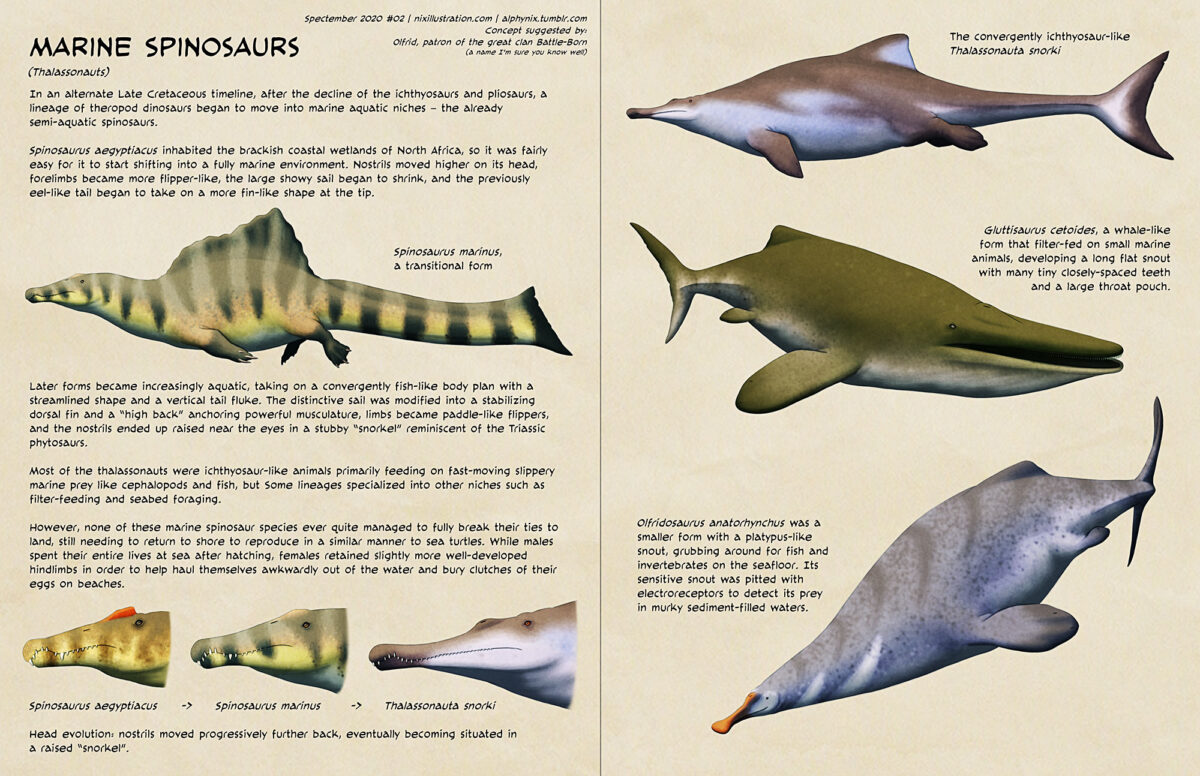Transcript for the text on the image under the cut:
PAGE 1
Spectember 2020 #02 | nixillustration.com | alphynix.tumblr.com
Concept suggested by:
Olfrid, patron of the great clan Battle-Born (a name I’m sure you know well)
Marine Spinosaurs
(Thalassonauts)
In an alternate Late Cretaceous timeline, after the decline of the ichthyosaurs and pliosaurs, a lineage of theropod dinosaurs began to move into marine aquatic niches – the already semi-aquatic spinosaurs.
Spinosaurus aegyptiacus inhabited the brackish coastal wetlands of North Africa, so it was fairly easy for it to start shifting into a fully marine environment. Nostrils moved higher on its head, forelimbs became more flipper-like, the large showy sail began to shrink, and the previously eel-like tail began to take on a more fin-like shape at the tip.
[Image: a marine descendant of Spinosaurus, with a smaller sail, flipper-like limbs, and a the start of a fish-like tip to its tail.]
Spinosaurus marinus, a transitional form
Later forms became increasingly aquatic, taking on a convergently fish-like body plan with a streamlined shape and a vertical tail fluke. The distinctive sail was modified into a stabilizing dorsal fin and a “high back” anchoring powerful musculature, limbs became paddle-like flippers, and the nostrils ended up raised near the eyes in a stubby “snorkel” reminiscent of the Triassic phytosaurs.
Most of the thalassonauts were ichthyosaur-like animals primarily feeding on fast-moving slippery marine prey like cephalopods and fish, but Some lineages specialized into other niches such as filter-feeding and seabed foraging.
However, none of these marine spinosaurs species ever quite managed to fully break their ties to land, still needing to return to shore to reproduce in a similar manner to sea turtles. While males spent their entire lives at sea after hatching, females retained slightly more well-developed hindlimbs in order to help haul themselves awkwardly out of the water and bury clutches of their eggs on beaches.
[Image: an evolutionary progress of marine spinosaur head anatomy]
Spinosaurus aegyptiacus → Spinosaurus marinus → Thalassonauta snorki
Head evolution: nostrils moved progressively further back, eventually becoming situated in a raised “snorkel”.
PAGE 2
[Image: an ichthyosaur-like marine spinosaur with a streamlined body, paddle-like limbs, a triangular dorsal sail and a vertical shark-like tail fluke.]
The convergently ichthyosaur-like Thalassonauta snorki
[Image: a whale-like marine spinosaur with a wide flat lid-like mouth, a large throat pouch, and the upper jaw lined with many tiny needle-like teeth.]
Gluttisaurus cetoides, a whale-like form that filter-fed on small marine animals, developing a long flat snout with many tiny closely-spaced teeth and a large throat pouch.
[Image: a vaguely platypus-like marine spinosaur with a relative small head and a wide duck-like snout.]
Olfridosaurus anatorhynchus was a smaller form with a platypus-like snout, grubbing around for fish and invertebrates on the seafloor. Its sensitive snout was pitted with electroreceptors to detect its prey in murky sediment-filled waters.

